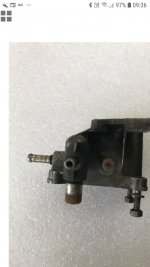While I agree with all the advice/suggestions made by timmycm850, I am deeply suspicious of those who 'modify' carbs especially any 'boring out' operations, fitting oversize shafts, bushes etc.
It doesn't take very much misalignment to complete upset the relative positions of the edge of the throttle disc (butterfly) and also the progression holes. The result can you 'chasing your tail' forever or until you get another carb.....
I note, however that OP was supplied with another rebuilt? carb with the rebuilt/modified engine, and that this carb displays the same problems. Was this carb modified in the same way by the same person?
If this was my car, I'd be looking for a known-to-be-working standard carb and try to get the engine starting easily, idling reliable and working normally.
Listening to the video of the engine running, it sounds to me like the idle circuit is not delivering any fuel - the engine seems to be running on fuel from the progression holes or maybe the emulsion tube circuit. The position of the idle mixture screw is also very suspect as timmycm850 has already pointed out. I can't recall if this Fiat carb has a tapered idle mixture screw or the type that looks like a little pin on the end, but on this latter type, the pin can be broken off and completely block the idle mixture hole - does turning the screw have any effect whatsoever? Have you tried removing the screw to check if any fuel comes out or can be blown through?
My (limited) experience on removing emissions equipment on a few cars imported from the USA over here, is that removing/blanking off some of these can have unforeseen effects. If you disconnect something that bleeds extra air into the engine under certain conditions, you may have to change e.g. extra jets, e.g. air-corrector jets. If you blank off the valve that timmcm850 mentions on the throttle shaft that's supposed to draw in oil fumes above idle speed, you may have to change a few jets also.
It's not unusual to have different size idle or indeed other jets in a twin choke carb - the 2 chokes can be different sizes, or for other reasons incl. emissions reduction, economy etc.
Re:- difficulty starting. If the idle circuit is not working, then the engine has to spun over faster to get it to 'catch'. I'm not sure if a 'high-torque' starter motor spins the engine faster or just has more torque???
I well remember having difficulty in getting the 850 engines to start after head gasket replacement ( it didn't happen on any other Fiats at that time).
some oil down the bores seemed to help, but often I simply resorted to doing a tow start for the initial start - no problem after that. (doesn't apply to OP's car as he's had it running several times already).
On the few engines I worked on that had modified cams etc, again, sometimes a tow start was the quickest way to start it ( insufficient starter speed may have been to blame). Some Mechanics loosen the distributor and try rotating the distributor back and forth (thereby advancing/retarding the static ignition timing a little) to get the engine to catch. If you over retard, you may get a backfire through the carb, if you over-advance the engine may kick back against the starter (iirc). When they got the engine running this way, they would adjust the timing to give the highest idle speed, retard slightly then re-check later using a strobelight on the timing marks.
Another thought has come to me :idea:. Many Fiat engines of c. 1970's used 5 degrees btdc as their static timing figure, unlike Euro spec engines which used 10 degrees btdc. This would cause difficulty starting, so on some models e.g. 124 the distributor was fitted with 2 sets of contact breaker points, one timed to 10 degrees for starting purposes and the other 5 degrees for normal running. Remember what I said about trying some advance on the ignition timing if difficulty starting is encountered.
In summary - I reckon Op's problems are in the carb, probably the idle circuit. Trying a known good standard carb should confirm/refute this. Very important to have no air leaks also.
Al.



